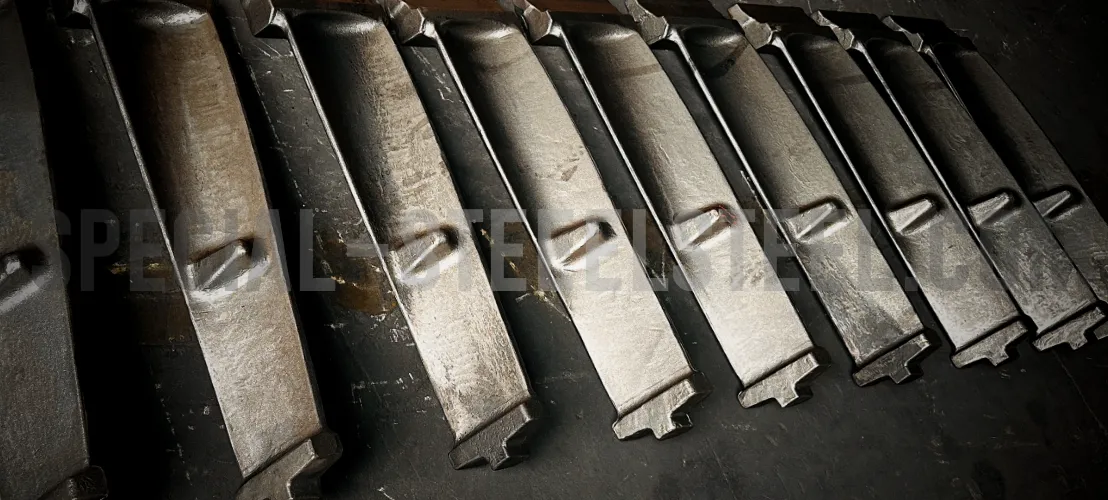
X19CrMoNbVN11-1 (1.4913): The Ideal Steel for Turbine and Compressor Blades

Dr. Robert Anderson
Senior Materials Scientist
When it comes to manufacturing high-performance turbine and compressor blades, selecting the right material is critical for ensuring durability, reliability, and efficiency under extreme conditions. One standout material in this domain is X19CrMoNbVN11-1, also known by its material number1.4913. This high-strength, heat-resistant steel, specified in standards like EN 10269 and detailed in technical documents such as TLV 9367 05, is engineered for applications where service temperatures reach up to 540°C. In this blog, we explore the properties, manufacturing requirements, and applications of X19CrMoNbVN11-1, making it the go-to choice for turbine and compressor blades.
What is X19CrMoNbVN11-1 (1.4913)?
X19CrMoNbVN11-1 is a martensitic stainless steel designed for high-temperature applications, particularly in the production of turbine and compressor blades. Its material number,1.4913, identifies it as a creep-resistant steel with excellent mechanical properties and corrosion resistance. This steel is typically supplied in a quenched and tempered (+QT) condition, ensuring optimal performance in demanding environments like power generation and aerospace.
The material’s composition and processing, as outlined in TLV 9367 05, make it suitable for rolled or forged steel bars used in milled turbine and compressor blades. Its ability to withstand high temperatures (≤540°C) and mechanical stress makes it a preferred choice for critical components in turbines and compressors.
Chemical Composition of X19CrMoNbVN11-1
The chemical composition of 1.4913 is carefully controlled to achieve the desired balance of strength, toughness, and corrosion resistance. According to TLV 9367 05, the melt analysis (in weight %) is as follows:
- Carbon (C): 0.17–0.23%
- Silicon (Si): ≤0.50%
- Manganese (Mn): 0.40–0.90%
- Phosphorus (P): ≤0.025%
- Sulfur (S): ≤0.015%
- Chromium (Cr): 10.0–11.5%
- Molybdenum (Mo): 0.50–0.80%
- Nickel (Ni): 0.20–0.60%
- Vanadium (V): 0.10–0.30%
- Niobium (Nb): 0.25–0.55%
- Nitrogen (N): 0.05–0.10%
- Boron (B): ≤0.0015%
- Aluminum (Al): ≤0.020% (target ≤0.010%)
This composition ensures that X19CrMoNbVN11-1 delivers high strength, creep resistance, and excellent fatigue properties, making it ideal for turbine and compressor blades operating under high thermal and mechanical loads.
Manufacturing Requirements for X19CrMoNbVN11-1
The production of X19CrMoNbVN11-1 steel bars for turbine and compressor blades involves stringent manufacturing processes to meet the specifications outlined in TLV 9367 05. Key steps include:
1. Melting and Degassing
To ensure high purity, X19CrMoNbVN11-1 is produced using degassed steel, typically vacuum-treated, with cast ingots as the starting material. This process minimizes inclusions and enhances material quality.
2. Heat Treatment
The steel undergoes a specific heat treatment process to achieve the required mechanical properties:
- Hardening: 1100–1130°C, followed by air or liquid quenching.
- Tempering: 670–750°C, with a minimum holding time of 2 hours.
- Stress Relieving: As per TLV 0110, additional stress-relieving treatments may be applied to reduce residual stresses.
These processes ensure that 1.4913 achieves the necessary strength, toughness, and microstructure forturbine and compressor blades.
3. Cleanliness and Microstructure
The cleanliness of X19CrMoNbVN11-1 is critical for its performance. The material must meet strict inclusion criteria:
- Thin series inclusions: Type A, B, C (max. 2), Type D (max. 2.5).
- Heavy series inclusions: Type A, B, C, D (max. 1.5).
- IR(D): ≤10.
Additionally, the delta ferrite content must be less than 5%, and the average grain size should be 4 or finer to ensure a robust microstructure.
Mechanical Properties of X19CrMoNbVN11-1
The mechanical properties of X19CrMoNbVN11-1 are tailored for high-performance applications. At room temperature, the steel must meet the following requirements:
- 0.2% Proof Strength: ≥780 MPa
- Tensile Strength: 900–1050 MPa
- Elongation After Fracture (A5): ≥12%
- Reduction of Area: ≥40%
- Absorbed Impact Energy (KV₂): ≥20 J (average of 3 samples, with a minimum of 14 J for any single sample)
- Hardness (HBW): 265–310
For transverse direction properties, the material must achieve:
- Elongation After Fracture (A5): ≥10%
- Reduction of Area: ≥25%
- Absorbed Impact Energy: ≥12 J (minimum 10 J for any single sample), with additional tests at 100°C requiring >20 J.
At elevated temperatures (550°C), a hot tensile test per ISO 6892-2 requires:
- 0.2% Proof Strength: ≥475 MPa
- Tensile Strength: ≥520 MPa
- Elongation After Fracture (A5): ≥16%
- Reduction of Area: ≥55%
These properties ensure that X19CrMoNbVN11-1 can withstand the demanding conditions of turbine and compressor blades in high-temperature environments.
Why Choose X19CrMoNbVN11-1 for Turbine and Compressor Blades?
X19CrMoNbVN11-1 (1.4913) is specifically engineered for turbine and compressor blades due to its:
- High Creep Resistance: Essential for long-term performance at temperatures up to 540°C.
- Superior Mechanical Strength: Ensures durability under high mechanical loads.
- Excellent Fatigue Resistance: Critical for components subjected to cyclic stresses.
- Corrosion Resistance: Provided by its high chromium content, making it suitable for harsh environments.
- Stringent Quality Control: Compliance with standards like EN 10269 and TLV 9367 05 ensures consistent performance.
Additionally, the material’s ability to meet strict cleanliness and microstructure requirements makes it ideal for precision-milled turbine and compressor blades used in power generation, aerospace, and industrial applications.
Applications of X19CrMoNbVN11-1
X19CrMoNbVN11-1 is primarily used in:
- Turbine Blades: For steam and gas turbines in power plants.
- Compressor Blades: In jet engines and industrial compressors.
- High-Temperature Components: In systems requiring creep resistance and durability at temperatures up to 540°C.
Its versatility and robust properties make it a cornerstone material in industries where reliability and performance are non-negotiable.
Conclusion
X19CrMoNbVN11-1 (1.4913) is a high-performance steel that excels in the demanding environment ofturbine and compressor blades. Its carefully controlled chemical composition, rigorous manufacturing processes, and exceptional mechanical properties make it a top choice for applications requiring strength, creep resistance, and durability at high temperatures. By adhering to standards like EN 10269 and TLV 9367 05, this material ensures reliability and efficiency in critical components.
For engineers and manufacturers looking to optimizeturbine and compressor blades, X19CrMoNbVN11-1 offers the perfect balance of performance and reliability. To learn more about its specifications or sourcing, refer to technical documents like TLV 9367 05 or contact your material supplier for detailed guidance.
Keywords: X19CrMoNbVN11-1, 1.4913, turbine and compressor blades, high-temperature steel, creep resistance, EN 10269, TLV 9367 05